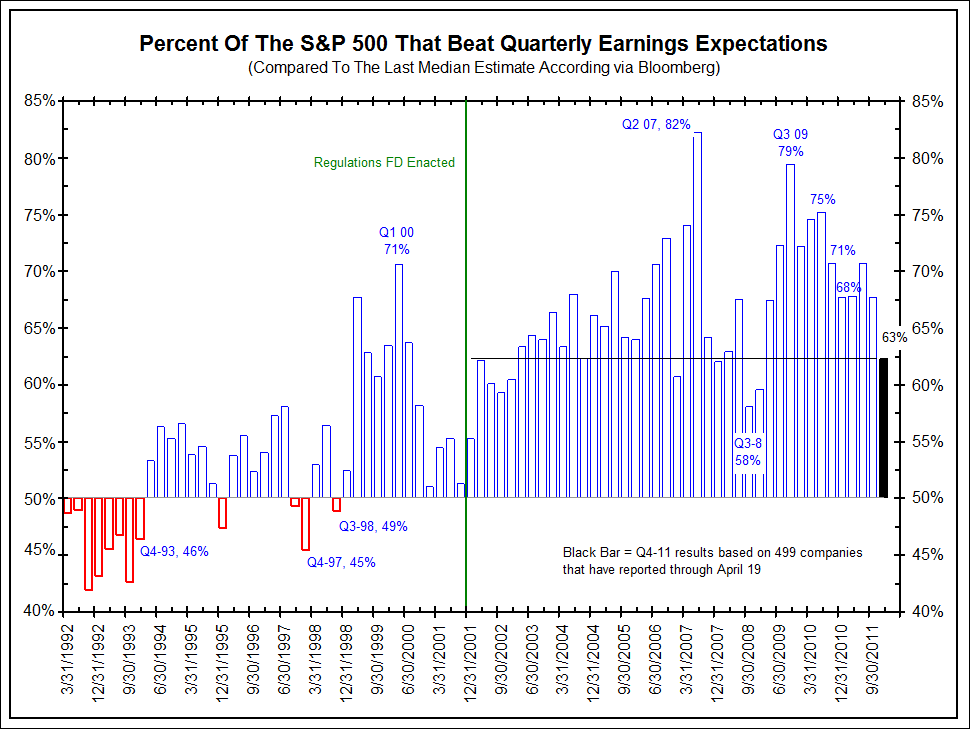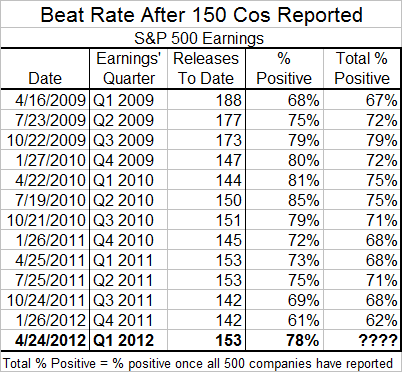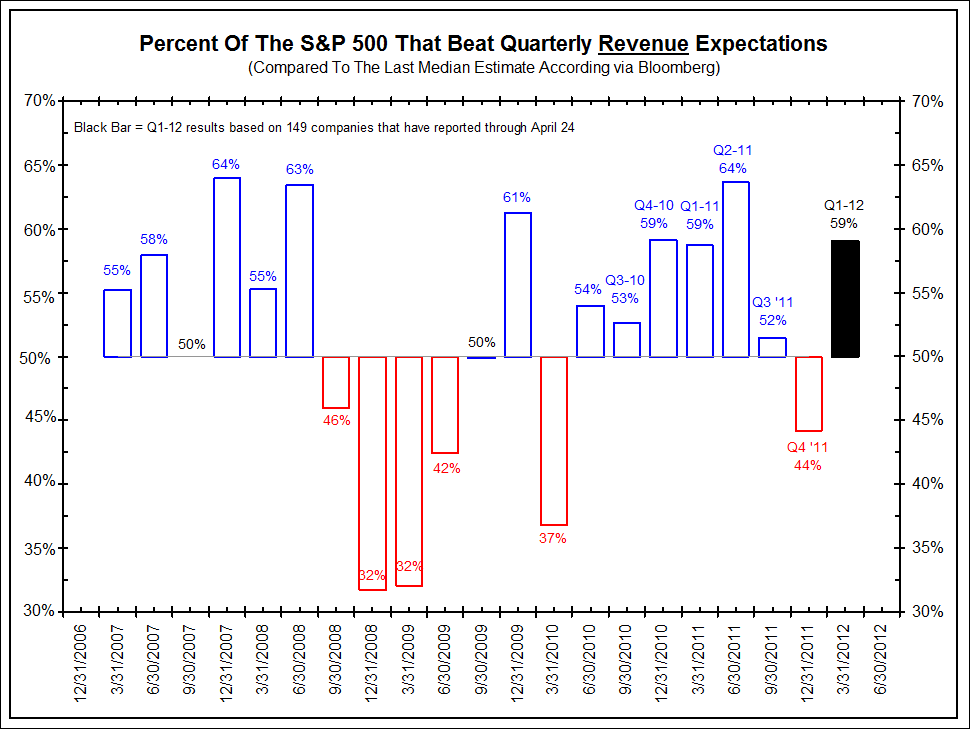Reuters.com – Analysis: Stronger earnings prove pessimists wrong
Wall Street may have written off corporate America too quickly.
In the early stages of the first-quarter reporting season, U.S. companies have beaten earnings forecasts at a rate of 79 percent. They have beaten revenue forecasts at a rate of 76 percent and expectations for overall corporate profit growth have climbed in a few short weeks, based on Thomson Reuters data for results through Monday. Earnings reports so far show that economic weakness in the euro zone and a slowdown in parts of the Chinese economy have not hurt sales and margins as feared. The earnings beats also suggest that companies have kept costs, including hiring, under control, which may not be such an optimistic signal for the U.S. labor market and economy. Profit expectations were low going into the reporting period, partly because of concerns about overseas demand for American products and increasing costs such as higher oil prices. Companies may have also been too conservative in their own forecasts. Less than two weeks into the reporting period, earnings for companies in the Standard & Poor’s 500 .SPX are expected to have increased 4.6 percent for the first quarter. That is above an estimate of 3.2 percent just before earnings began and above a forecast of about 2 percent in February, according to Thomson Reuters data.
Globe And Mail – An earnings season only a pessimist could love
U.S. companies have been clearing earnings hurdles in record numbers this quarter. But the market is more focused on how low the bar has been set. With more than 25 per cent of S&P 500 companies having reported their first-quarter results, 80 per cent have exceeded analysts’ consensus profit estimates – a record pace, and well above the historical average of 62 per cent. But the stock market has been falling even as the numbers have hit the presses over the past two weeks. The record “beat rate,” as earnings trackers call it, can’t gloss over the fact that earnings forecasts have been in decline for months – leaving expectations so low that topping them is a dubious achievement. “We’re still not looking at great growth,” said John Butters, senior earnings analysts at market analytics firm Factset Research Systems Inc. Major earnings-tracking services such as Factset, Thomson Reuters Research and S&P Capital IQ expect S&P 500 year-over-year earnings growth of between 4 and 4.5 per cent for the quarter ended March 31. That would be the weakest profit growth in more than two years. With roughly half of the S&P 500’s revenues coming from outside the United States, the companies that make up the index are feeling the deepening gloom surrounding the European and Chinese economies. Wall Street analysts have been lowering their earnings estimates for the past six months, a process that accelerated in the early part of this year as companies issued a flood of warnings that their first-quarter numbers wouldn’t live up to forecasts. Rising energy costs have raised concerns of a further profit pinch.
Comment
Long time readers will know that we have called earnings beat rates a meaningless statistic. Companies always handily “beat” the consensus and get the positive press and accolades that come with it. Further, it seems that everyone is happy with this apparent gaming of the system. The game is designed for this to happen, even when earnings are collapsing (during 2008′s epic collapse in earnings more than 50% of companies still beat expectations).
The chart below highlights the inception of SEC regulation “FD” (aka, Fair Disclosure) in green. Before FD roughly 50% of companies beat expectations, as would be the case if analysts were trying to get it right. Now that companies have to disclose to all at the same time, we believe their investor relations departments are masters at “guiding” analysts just below actual earnings to engineer a positive surprise.
Click to enlarge:
What about the current earnings beat rate? The table below shows the earnings beat rate after 150 S&P 500 companies have reported since the end of the Great Recession. The last line shows that 78% of the companies that have reported Q1-2012 earnings have beat expectations. While this sounds impressive, note that from 2009 to 2011 that was more or less inline with what gets reported after 150 results are in. So, this beat rate to-date is nothing unusual, especially when you consider that these estimates are greatly reduced from a few months ago as detailed yesterday.
The market knows all this, as the next chart shows. The x-axis shows the S&P 500′s return during earnings season (defined as the month after the quarter ends). The y-axis shows the percentage of S&P 500 companies that beat expectations (when the quarter is complete and all companies have reported).
The chart looks like a shot-gun blast. The regression shows a near random correlation of 1%. Simply put, knowing the percentage of companies that will beat earnings is of little value in trading the S&P 500. Just look at this quarter. While everyone is gushing about a 80% beat rate, the S&P 500 is down 2.7% for the month. Beats rates are not that important.
Finally, the chart below shows the beat rate for revenues. It shows the completed quarters and the current quarter (black bar) to-date.
At first blush revenues appear to offer a more honest view of companies’ financial outlooks than earnings. If analysts were actually trying to get it right, the number of companies beating the benchmark should vacillate around 50%. Revenues estimates do exactly this.
To-date, 59% of reported companies have beaten on the revenue line. This is a nice number, but nothing extraordinary. The current quarter’s revenue beat rate is less than the 64% beat rate last July when Q2-2011 results were coming in. The market celebrated these beats by declining 2.0% during that reporting season, again underscoring that these beat rates do not move the market.
Source: Bianco Research






What's been said:
Discussions found on the web: